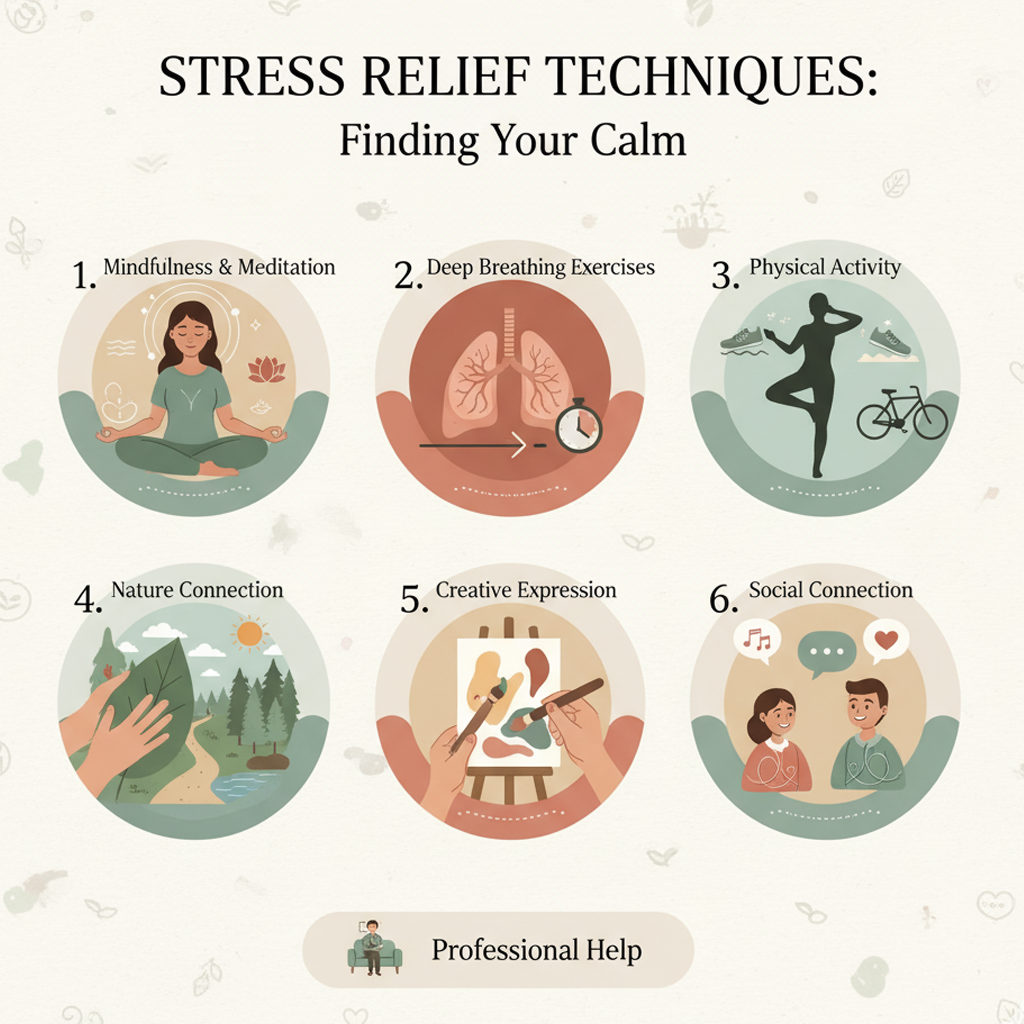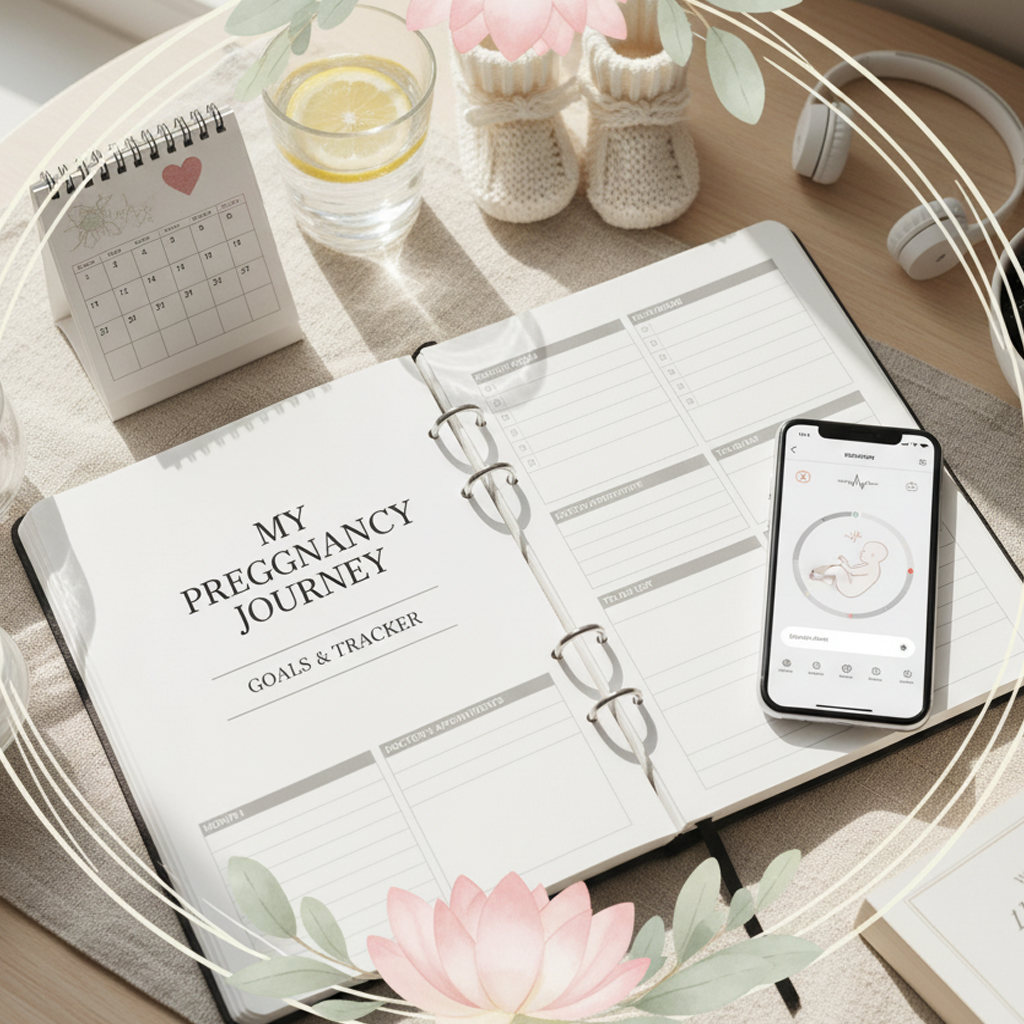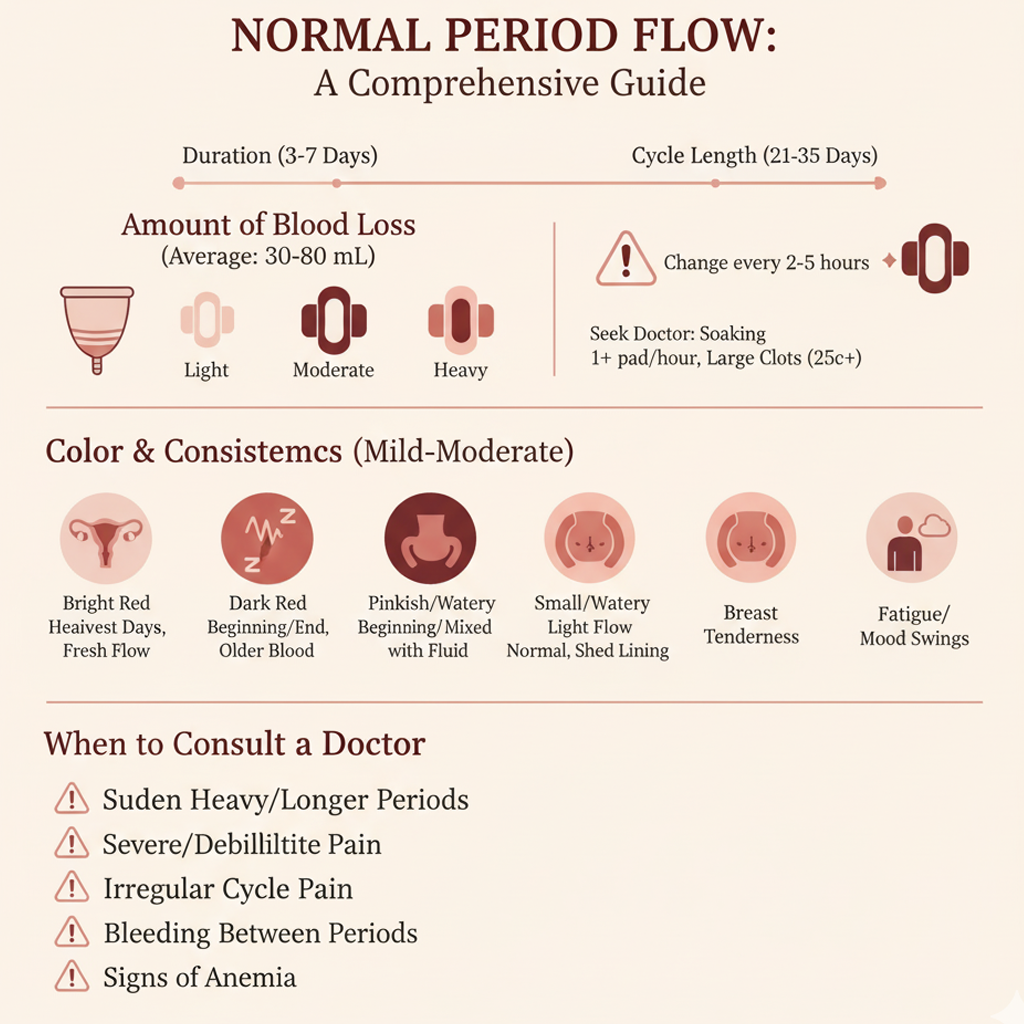Stress Relief Techniques

Managing stress during menstruation or pregnancy is essential for hormonal balance, reproductive health, and overall well-being. Stress can exacerbate menstrual symptoms, disrupt cycles, or impact pregnancy outcomes, so these techniques aim to promote relaxation and emotional resilience. Always consult a healthcare provider if stress feels overwhelming or is accompanied by other concerning symptoms, especially during pregnancy.
1. Practice Deep Breathing Exercises
-
Technique:
-
Sit or lie in a comfortable position. Inhale deeply through your nose for 4 seconds, hold for 4 seconds, and exhale slowly through your mouth for 6 seconds.
-
Repeat for 5–10 minutes daily or during stressful moments.
-
-
Benefits: Lowers cortisol levels, reduces heart rate, and calms the nervous system.
-
Tips:
-
Practice in a quiet space, using a timer to maintain focus.
-
Use during menstrual cramps or pregnancy-related anxiety for quick relief.
-
-
Purpose: Provides an accessible, immediate way to reduce stress and promote relaxation.
2. Engage in Mindfulness Meditation
-
Technique:
-
Find a quiet, comfortable spot. Focus on your breath or a simple word (e.g., “calm”) for 5–10 minutes.
-
If thoughts arise, acknowledge them without judgment and return to your focus.
-
-
Benefits: Enhances emotional regulation and reduces stress-related symptoms like irritability or fatigue.
-
Tips:
-
Start with short sessions (5 minutes) and gradually increase duration.
-
Use during premenstrual syndrome (PMS) or pregnancy to manage mood swings.
-
-
Purpose: Builds mental clarity and resilience, supporting cycle or pregnancy health.
3. Try Gentle Physical Activity
-
Technique:
-
Engage in 10–30 minutes of moderate exercise, such as walking, prenatal yoga (if pregnant), or stretching, 3–5 times weekly.
-
For menstruation, focus on gentle movements to ease cramps; for pregnancy, choose pregnancy-safe exercises (e.g., pelvic tilts).
-
-
Benefits: Releases endorphins, improves mood, and reduces tension.
-
Tips:
-
Avoid intense exercise during heavy menstrual flow or late pregnancy unless cleared by your provider.
-
Pair with deep breathing for enhanced relaxation.
-
-
Purpose: Supports physical and emotional health while maintaining cycle regularity or pregnancy comfort.
4. Use Progressive Muscle Relaxation (PMR)
-
Technique:
-
Lie down or sit comfortably. Tense and then relax each muscle group (e.g., feet, legs, arms, shoulders) for 5–10 seconds each, moving from toes to head.
-
Complete a full-body session in 10–15 minutes.
-
-
Benefits: Reduces muscle tension and stress, especially helpful for menstrual cramps or pregnancy-related discomfort.
-
Tips:
-
Practice before bed to improve sleep quality.
-
Use during periods of high stress or before prenatal appointments.
-
-
Purpose: Relieves physical and mental tension, promoting relaxation.
5. Journal for Emotional Release
-
Technique:
-
Write in a notebook for 5–10 minutes daily, noting feelings, stressors, or positive moments.
-
During menstruation, log PMS symptoms or mood changes; during pregnancy, record emotions or baby milestones.
-
-
Benefits: Processes emotions, reduces stress, and provides clarity.
-
Tips:
-
Use prompts like “What’s causing stress today?” or “What felt calming?”
-
Review entries to identify stress triggers and discuss with your provider if needed.
-
-
Purpose: Enhances emotional awareness and supports mental health tracking.
6. Create a Relaxation Routine
-
Technique:
-
Set aside 10–20 minutes daily for a combination of techniques (e.g., 5 minutes of deep breathing, 10 minutes of stretching).
-
Create a calming environment with dim lighting, soft music, or a comfortable chair.
-
-
Benefits: Builds consistency, reducing chronic stress and its impact on cycles or pregnancy.
-
Tips:
-
Schedule relaxation during natural energy dips (e.g., mid-afternoon) or after stressful events.
-
Use a timer or phone reminder to maintain a daily habit.
-
-
Purpose: Integrates stress relief into daily life for sustained benefits.
7. Connect with a Support System
-
Technique:
-
Talk to your partner, family, or friends about stressors or pregnancy concerns.
-
Join local or online groups for menstruating individuals or expectant parents to share experiences.
-
-
Benefits: Reduces feelings of isolation and fosters emotional support.
-
Tips:
-
Schedule regular check-ins with loved ones to discuss feelings or cycle/pregnancy updates.
-
Seek groups through community centers or online forums (search for general terms like “pregnancy support” or “menstrual health”).
-
-
Purpose: Strengthens emotional resilience through shared understanding.
8. Track Stress and Relief Outcomes
-
Action: Use a notebook, calendar, or digital reminder system to log:
-
Stress levels (e.g., mild, moderate, severe) and triggers (e.g., work, PMS, pregnancy symptoms).
-
Stress relief techniques used and their effectiveness (e.g., “10-min meditation, felt calmer for 2 hours”).
-
Related symptoms (e.g., irregular cycles, fatigue) to discuss with your provider.
-
-
Tips:
-
Track daily for 3–6 cycles or throughout pregnancy to identify patterns.
-
Note improvements in mood, sleep, or physical symptoms after using techniques.
-
-
Purpose: Helps evaluate which methods work best and flags persistent stress for medical review.
9. Know When to Seek Medical Advice
-
Warning Signs:
-
Persistent or overwhelming stress that disrupts daily life or sleep.
-
Physical symptoms like irregular cycles, severe cramps, or reduced fetal movement (in pregnancy) linked to stress.
-
Signs of anxiety or depression (e.g., constant worry, loss of interest in activities).
-
-
Action: Consult a healthcare provider if stress feels unmanageable or is accompanied by concerning symptoms, especially during pregnancy.
-
High-Risk Pregnancies: If you have conditions like hypertension or a history of preterm birth, discuss stress management plans with your provider.
-
Purpose: Ensures timely intervention for stress-related health issues.
Benefits
-
Hormonal Balance: Reduces cortisol, supporting regular menstrual cycles and healthy pregnancy.
-
Improved Well-Being: Enhances mood, energy, and emotional resilience.
-
Better Health Outcomes: Lowers stress-related risks like cycle irregularities or pregnancy complications.
Practical Tips
-
Tracking Tools: Log stress levels and relief techniques in a journal (e.g., “Day 10: moderate stress from work, 5-min breathing helped”). Include cycle or pregnancy symptoms for context.
-
Environment Setup: Create a dedicated relaxation space with a comfortable chair, dim lighting, or calming scents (e.g., lavender essential oil, if safe).
-
Short Sessions: Start with 5-minute techniques (e.g., breathing, PMR) if time is limited, gradually increasing as comfortable.
-
Nutrition Support: Pair stress relief with a balanced diet (e.g., magnesium-rich foods like bananas or almonds) to enhance relaxation.
-
Partner Involvement: Share stress relief practices with your partner (e.g., joint yoga or meditation) to build mutual support.
-
Routine Integration: Schedule stress relief during daily transitions (e.g., after work, before bed) to maintain consistency.
Actionable Next Steps
-
Today: Choose a tracking tool and try a 5-minute deep breathing exercise. Log your stress level and outcome.
-
This Week: Test 2–3 techniques (e.g., meditation, gentle stretching) and record their effectiveness.
-
Next 3–6 Cycles or Trimesters: Build a daily relaxation routine and track stress patterns. Adjust techniques based on what works best.
-
Ongoing: Consult a healthcare provider if stress persists, disrupts cycles, or affects pregnancy.
Related Articles

Week 27 - End of Second Trimester

Pregnancy Goal Setting

Week 12 - End of First Trimester

Symptom Alert System

Normal Period Flow

Week 22 - Lung Maturation

Week 25 - Brain Growth Spurt

Week 28 - Rapid Weight Gain